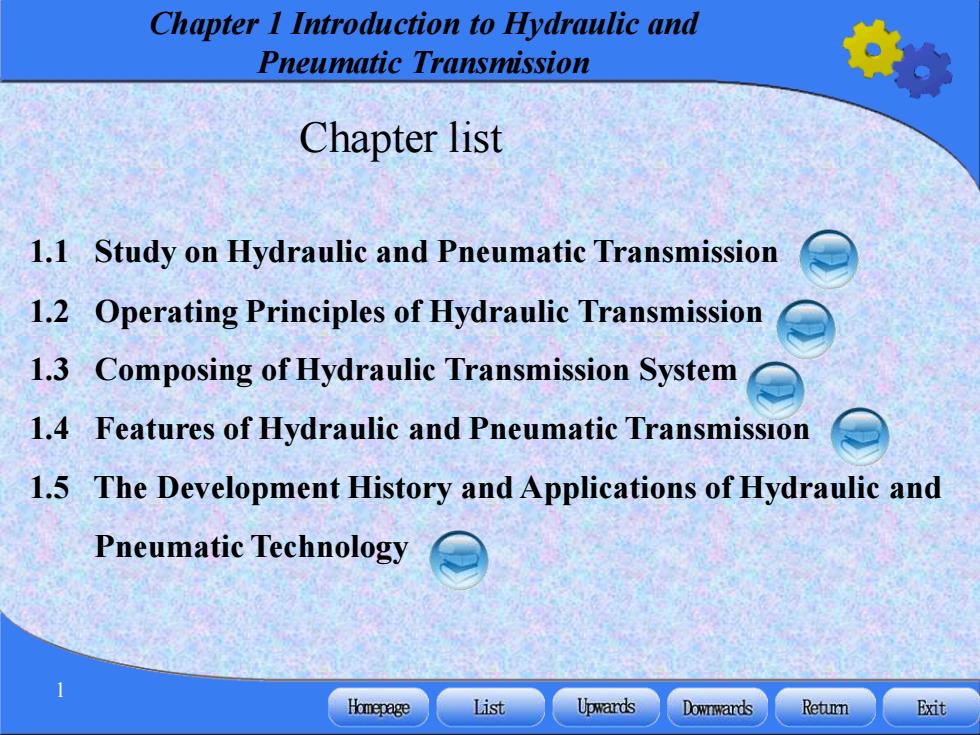
Chapter I Introduction to Hydraulic and Pneumatic Transmission Chapter list 1.1 Study on Hydraulic and Pneumatic Transmission 1.2 Operating Principles of Hydraulic Transmission 1.3 Composing of Hydraulic Transmission System 1.4 Features of Hydraulic and Pneumatic Transmission 1.5 The Development History and Applications of Hydraulic and Pneumatic Technology Homepage List Upwards Downwards Retumn Exit
Chapter 1 Introduction to Hydraulic and Pneumatic Transmission 1 1.1 Study on Hydraulic and Pneumatic Transmission 1.2 Operating Principles of Hydraulic Transmission 1.3 Composing of Hydraulic Transmission System 1.4 Features of Hydraulic and Pneumatic Transmission 1.5 The Development History and Applications of Hydraulic and Pneumatic Technology Chapter list
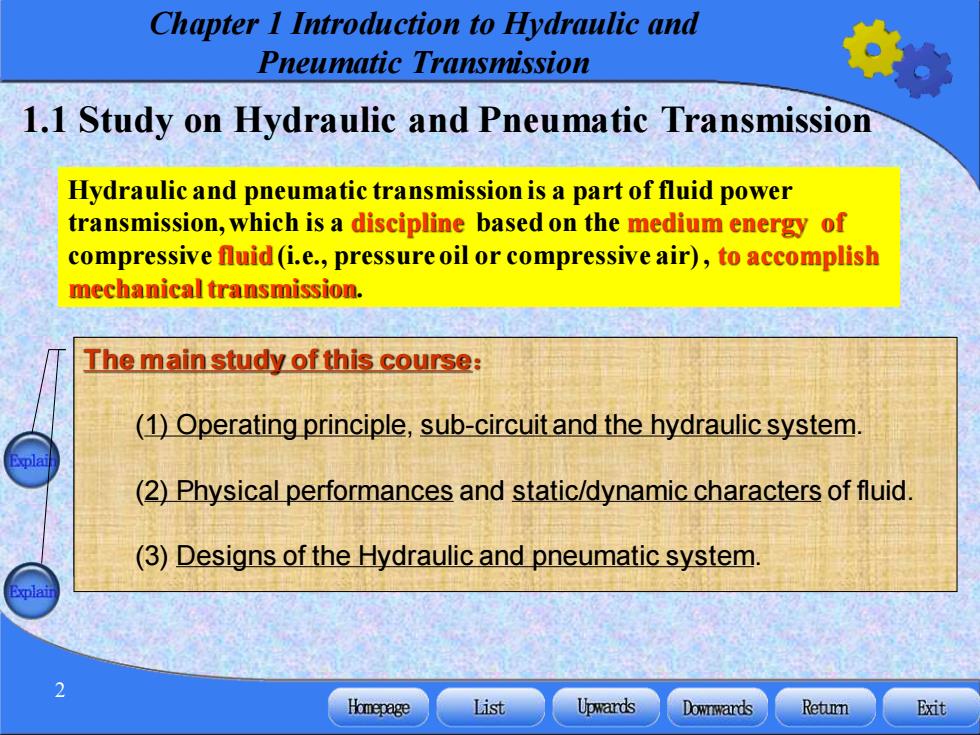
Chapter I Introduction to Hydraulic and Pneumatic Transmission 1.1 Study on Hydraulic and Pneumatic Transmission Hydraulic and pneumatic transmission is a part of fluid power transmission,which is a discipline based on the medium energy of compressive fluid(i.e.,pressure oil or compressive air),to accomplish mechanical transmission. The main study of this course: (1)Operating principle,sub-circuit and the hydraulic system. p (2)Physical performances and static/dynamic characters of fluid. (3)Designs of the Hydraulic and pneumatic system. Homepage List Upwards Downwards Retun Exit
Chapter 1 Introduction to Hydraulic and Pneumatic Transmission 2 1.1 Study on Hydraulic and Pneumatic Transmission Hydraulic and pneumatic transmission is a part of fluid power transmission, which is a discipline based on the medium energy of compressive fluid (i.e., pressure oil or compressive air) , to accomplish mechanical transmission. The knowledge points of this chapter: The basic operating principle, buildup of the system, the characters and application of hydraulic and pneumatic transmission, and the trend of its development. The difficulty of this chapter: Grasp of the two important characters which obtain fluid power transmission. The main study of this course: (1) Operating principle, sub-circuit and the hydraulic system. (2) Physical performances and static/dynamic characters of fluid. (3) Designs of the Hydraulic and pneumatic system
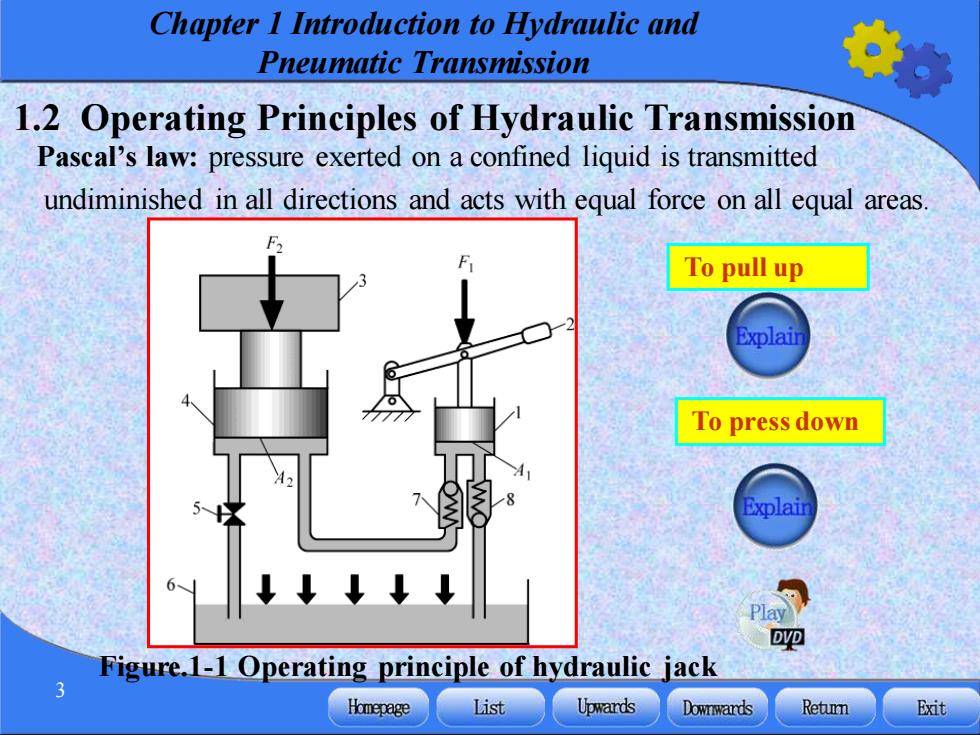
Chapter I Introduction to Hydraulic and Pneumatic Transmission 1.2 Operating Principles of Hydraulic Transmission Pascal's law:pressure exerted on a confined liquid is transmitted undiminished in all directions and acts with equal force on all equal areas. To pull up To press down Explain DVD Figure.1-1 Operating principle of hydraulic jack Homepage List Upwards Downwards Retun Exit
Chapter 1 Introduction to Hydraulic and Pneumatic Transmission 3 1.2 Operating Principles of Hydraulic Transmission Pascal’s law: pressure exerted on a confined liquid is transmitted undiminished in all directions and acts with equal force on all equal areas. Figure.1-1 Operating principle of hydraulic jack To pull up To press down
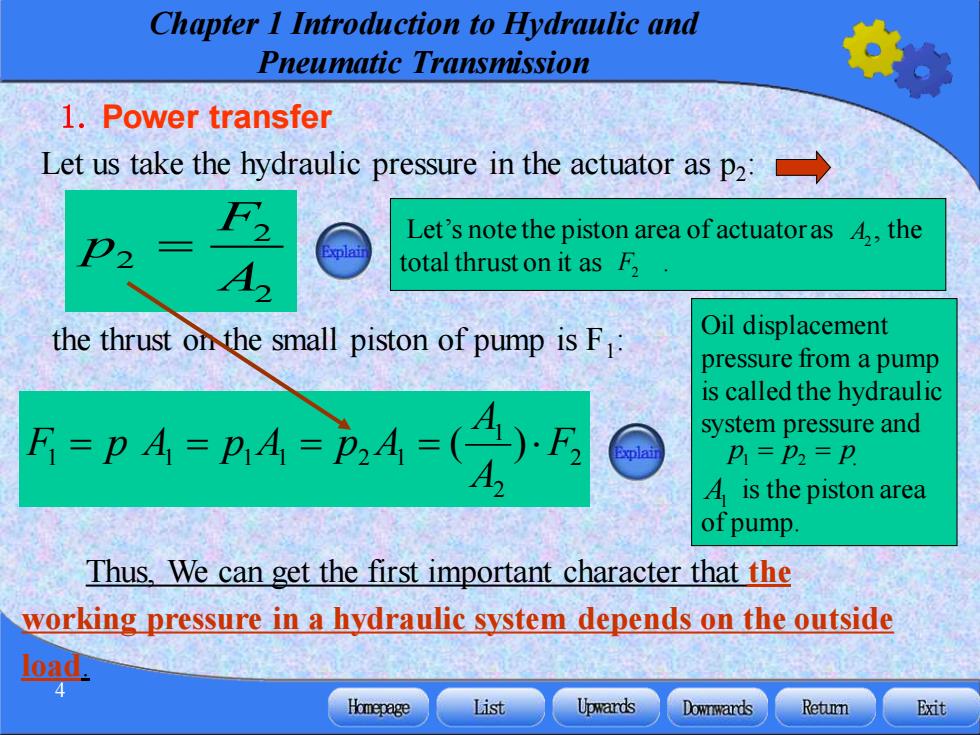
Chapter I Introduction to Hydraulic and Pneumatic Transmission 1.Power transfer Let us take the hydraulic pressure in the actuator as p2: F2 Let's note the piston area of actuatoras 4,the plai total thrust on it as F, the thrust on the small piston of pump is F: Oil displacement pressure from a pump is called the hydraulic F=pA=B4=4=(4)E system pressure and P=P2=P A is the piston area of pump Thus,We can get the first important character that the working pressure in a hydraulic system depends on the outside Homepage List Upwards Downwards Retun Exit
Chapter 1 Introduction to Hydraulic and Pneumatic Transmission 4 (1-1) (1-2) 1. Power transfer Thus, We can get the first important character that the working pressure in a hydraulic system depends on the outside load. 2 2 2 F p A = 2 2 1 1 1 1 1 2 1 ( ) F A A F = p A = p A = p A = Oil displacement pressure from a pump is called the hydraulic system pressure and . is the piston area of pump. Let us take the hydraulic pressure in the actuator as p2 : the thrust on the small piston of pump is F1 : Let’s note the piston area of actuator as , the total thrust on it as . F2 A2 1 2 p p p = = A1
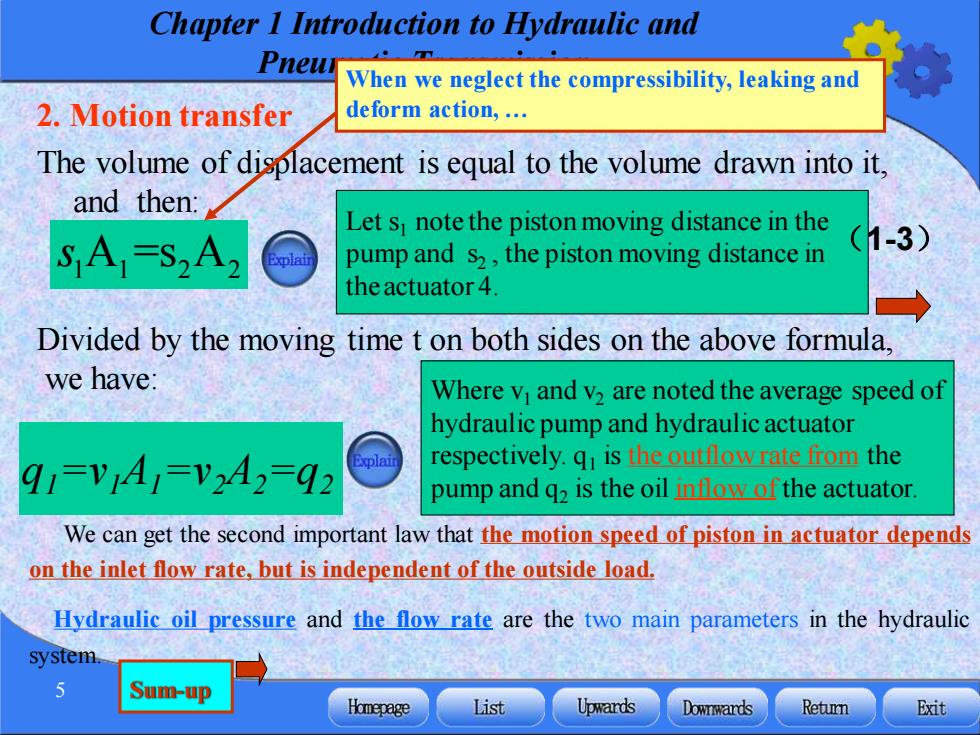
Chapter I Introduction to Hydraulic and Pneur When we neglect the compressibility,leaking and 2.Motion transfer deform action,. The volume of displacement is equal to the volume drawn into it, and then: Let s note the piston moving distance in the SA=S2A2 pump and s2,the piston moving distance in (1-3) the actuator 4 Divided by the moving time t on both sides on the above formula. we have: Where v and v2 are noted the average speed of hydraulic pump and hydraulic actuator 91=V1A1=V2A2=92 respectively.q is the outflow rate from the pump and q2 is the oil inflow of the actuator We can get the second important law that the motion speed of piston in actuator depends on the inlet flow rate,but is independent of the outside load Hydraulic oil pressure and the flow rate are the two main parameters in the hydraulic system. 5 Sum-up Homepage List Upwards Downwards Retumn Exit
Chapter 1 Introduction to Hydraulic and Pneumatic Transmission 5 (1-4) We can get the second important law that the motion speed of piston in actuator depends on the inlet flow rate, but is independent of the outside load. Hydraulic oil pressure and the flow rate are the two main parameters in the hydraulic system. s1 1 2 2 A =s A 2. Motion transfer The volume of displacement is equal to the volume drawn into it, and then: Let s1 note the piston moving distance in the pump and s2 , the piston moving distance in theactuator 4. (1-3) Divided by the moving time t on both sides on the above formula, we have: Where v1 and v2 are noted the average speed of hydraulic pump and hydraulic actuator respectively. q1 is the outflow rate from the pump and q2 is the oil inflow of the actuator. q1=v1A1=v2A2=q2 When we neglect the compressibility, leaking and deform action, . Sum-up